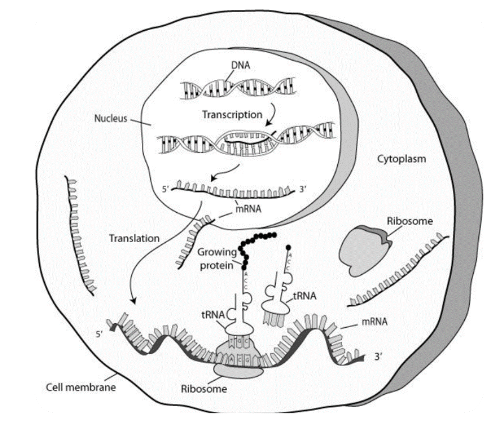Genes do not directly produce protein, but they provide information to build proteins. Protein production is completed in two ways: transcription and translation. Both the transcription and translation keep the information in DNA and then use it for protein production. A strand of DNA is being used by transcription as a template for building a molecule known as RNA. Transcription and translation are the two processes for converting the nucleotides sequence from DNA to make a sequence of amino acids for building the desired protein. These two processes are essential for life. For example, they are available in prokaryotic and eukaryotic organisms.
What are Transcription and Translation
The process following which DNA is copied to RNA is known as transcription, and the process by which RNA is used for producing protein is known as translation.
Transcription overview
The first step of gene expression is known as transcription. In the transcription process, the sequence of DNA of a gene is copied into RNA. It uses one of the two exposed DNA strands like a template, and this strand is known as the template strand. The product of RNA is complementary to the template strand, and it is fully similar to other DNA strands, known as a nontemplate strand.
Transcription initiation
For beginning a gene transcription, the RNA polymerase binds the gene’s DNA at the promoter region. Then, the polymerase listens to the promoter about where to settle on the DNA to begin transcribing.
Translation overview
In transcription, mRNA is formed and transported out of the nucleus via the cytoplasm to the ribosome. In this process, it directs the synthesis of protein. In protein synthesis, messenger RNA is not involved directly. For this synthesis, tRNA is required. The process following which mRNA directs the protein synthesis in association with tRNA is known as translation.
The large complex of protein and RNA molecules is known as the ribosome. mRNA’s three-base stretch is called a codon. One codon consists of the information on specific amino acids. Through the ribosome, mRNA passes, and every codon interacts with the antidote of a particular tRNA molecule by pairing the Watson-Crick base, the tRNA molecule takes an amino acid at the 3’-terminus, and it is incorporated into the protein chain that is growing.
Localisation of Transcription and Translation
Because of the absence of a nucleus in prokaryotes, both transcription and translation stay in the cytoplasm. Transcription occurs in the nucleus in the eukaryote, and translation occurs in ribosomes in the presence of cytoplasm on the rough endoplasmic membrane.
Factors of Transcription and Translation
RNA polymerase performed the transcription and other associated proteins known as transcription factors. It is easily inducible, as shown in the Spatio-temporal regulation for gene development as constitutive in genes like Gapdh.
Transcription and Translation Diagram
A transcription and translation diagram is shown below:

Comparison between Transcription and Translation
- The main purpose of transcription is to create RNA copies of individual genes that the cell can use in biochemistry. Translation also synthesises proteins. And these proteins are used for millions of cellular functions.
- Transcription can be defined as the use of genes as a template for producing several functions in the form of RNA. Translation can be defined as protein synthesis from an mRNA template. For gene expression, it is the second step.
- The products of transcriptions are tRNA, mRNA, rRNA, and non-coding RNA (for example, microRNA). And the products of translation are proteins.
- Transcription is situated in the Nucleus, and translation is situated in Cytoplasm.
- Transcription occurs in the time when the RNA polymerase protein binds to promote DNA and then forms the initiation complex of transcription. Translation occurs when initiation factors, ribosome subunits, and tRNA bind the mRNA beside the start codon AUG.
- Transcription is inhibited by 8-Hydroxyquinoline and rifampicin. And translation is inhibited by cycloheximide, anisomycin, tetracycline, chloramphenicol, puromycin, erythromycin, etc.
Conclusion
On a concluding note, in this article, we have learned about the process of transcription and translation. The process by which DNA is copied to RNA is known as transcription, and the process by which RNA is used for producing protein is known as translation. The products of transcriptions are tRNA, mRNA, rRNA, and non-coding RNA (for example, microRNA). And the products of translation are proteins. Transcription occurs in the nucleus in the eukaryote and translation occurs in ribosomes in the presence of cytoplasm on the rough endoplasmic membrane.
 Profile
Profile Settings
Settings Refer your friends
Refer your friends Sign out
Sign out






